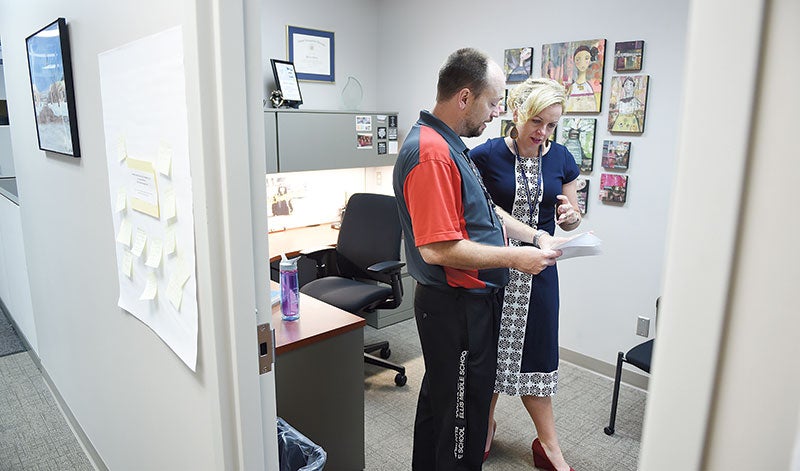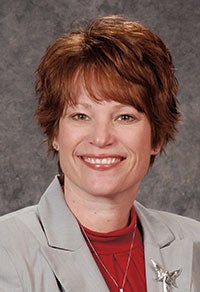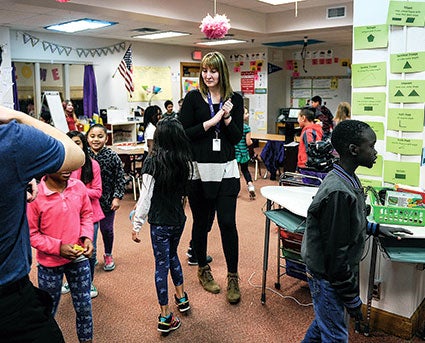Growing Leaders: In times of teacher shortage, APS continues to sustain
Published 7:41 am Tuesday, September 4, 2018

- New Ellis Middle School principal Jessica Cabeen goes over some material with assistant principal David Rezny before the start of this year’s school year. Cabeen, herself having a long tenure in Austin Public Schools, takes an active roll in helping retain Austin’s teachers. Eric Johnson/photodesk@austindailyherald.com
Editor’s Note: This is the second of a two-part series exploring Austin Public Schools’ ability to retain and to grow leaders and educators amid a nationwide and statewide teacher shortage.
Read the first part here: Packer Pride: Why these new principals call Austin Public Schools home
When Sumner Elementary School Principal Sheila Berger started working in the Austin Public Schools District more than a decade ago, there would be around 150 applicants for a job as a teacher, with intense competition to become an educator.

Sheila Berger
“I remember when I first started 15 years ago, we had more than 100 people apply,” Berger said. “Last year, we had 10.”
The dwindling number of applicants have been attributed to a statewide and nationwide shortage of teachers, with many area school districts impacted by those trends. According to the Minnesota Department of Education (MDE) released the 2017 Teacher Supply and Demand Report, which found the following:
Hiring official survey responses indicated that the limited number of applicants for job openings was a larger barrier to hiring qualified teachers than testing requirements or licensing standards
Districts expressed that filling both short-term and long-term substitutes was more difficult than reported in the 2012 and 2014 supply and demand surveys
Hiring officials predicted that within the next five years, the most difficult staff to hire will be special education teachers, teachers with multiple licenses, math and chemistry teachers.
Staff predicted to be the least difficult to hire would be elementary teachers, social studies teachers, and communication arts and literature (English) teachers.
For APS, there had been a decrease in the number of external candidates applying for positions within recent years, according to Mark Raymond, human resources director. Despite this, the district had been able to sustain and also grow their own leadership, as a way to respond to the forecasted teacher shortage.
Recently, the district had openings in their buildings for new principals and were able to hire from within, rather than having to seek external candidates. One of those examples included the posting for Woodson Kindergarten Center, where there were seven applicants who were all candidates from within the district.
“We have had a very stable principal group during the last two years,” Raymond said. “Some individuals moved on, and some retired. We have had teachers with years of experience in the double-digits and principals who were willing to stay with us for a number of years.”
However, once hired, the next challenge would be able to sustain and retain staff. The MDE report also addressed the obstacles that school districts faced when it came to retaining teachers. From the report, it was found that the number of teachers leaving their positions increased 34 percent since 2008-09, with the largest number of teachers leaving because of retirement, personal reasons, or because they have taken a position in another district.
The average number of teachers leaving the profession after one year was about 15 percent and over a quarter of teachers leaving the profession after three years was almost 26 percent.

Caitlin Haugland walks through the third-grade pod room as students prepare for a class activity in 2017. Haugland, who is currently a third grade teacher at Sumner Elementary, was part of the 2 + 2 program, which works to retain young teachers. Herald file photo
Answering a challenge
When new teachers enter the profession, it may not be necessarily what they had imagined when they started their education and not realize what the demands of being a teacher would entail.
“The public perception of teachers doesn’t necessarily treat them well,” Berger explained. “There are less and less resources, and you expect them to do more.”
Public school officials were asked to respond to questions regarding barriers in retaining qualified teachers. The MDE report survey data indicated that hiring officials at district and charter schools believed that the two largest barriers were a competitive job market and teacher salary. Another relatively low perceived barrier for teacher retention was teacher support.
Ellis Middle School Principal Jessica Cabeen had felt that new teachers often find themselves “burned out” after not being able to effectively balance life and work. Something of which, Cabeen admitted, she had also struggled with herself. However, she also stated that the district had taken the initiative in ensuring that teachers focus on “self-care.”
“I try not to send emails to staff during the weekend,” she said. “Teachers, they need to unplug. Their job, it’s hard to turn off and at some point they need to take some time and breathe. It’s about gaining balance. Teaching is such a caring profession and you have to set boundaries. You have to take care of yourself first.”
There’s also a sense of disconnect for prospective teachers who may still be exploring whether the profession was meant for them.
However, one of the ways that APS had been able to retain teachers and grow leadership was the 2+2 program, which was a partnership among APS, Riverland Community College and Winona State University which was created specifically in the face of teacher shortages and housed in Sumner Elementary School.
Berger said they’ve been able to hire some of those students who were able to quickly apply what they’ve learned in the classrooms at Sumner, as teachers. Last year, five teachers were hired from the 2+2 program, further cementing themselves into the APS district.
“You’re kind of on a job interview for the next two years,” she said. “We get to show these students our best and hopefully entice them to stay as well.”
Aside from programs in place to help grow teachers in numbers, the district also provided multiple opportunities to invest in their current staff and help them grow personally as leaders themselves.
Superintendent David Krenz said that APS provides ample opportunities to build upon staff strengths such as having chances to attend seminars and conferences outside of the district, as well as giving teachers chances to exercise their leadership skills through committees, coaching sports or advising a school club.
There’s also opportunities to move within the district to other teaching positions when made available, and not be restricted to certain positions for years.
“We want to support our teachers so they can grow and be given the best chance to be successful,” he added.
By investing in others, often times, they’ll invest right back into the community, Krenz added, and are more likely to build their lives Austin, and stay in the district for years to come, maybe entering double-digit years of service.
“What good is it to have good people, but you can’t even keep them?” he said.



